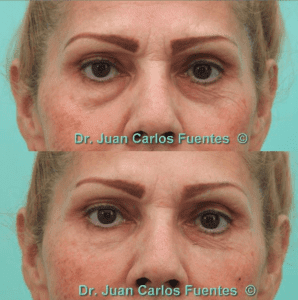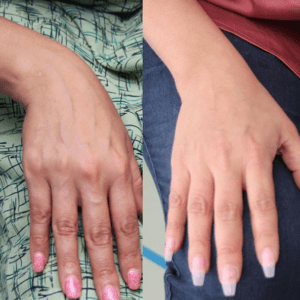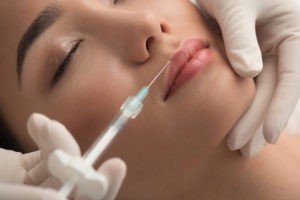Fillers, Botox & More: How to Choose the Best Injectable | VIDA
Once upon a time, Botox was the only injectable people talked about. However, there are now more injectables with amazing qualities that help people look younger.
If you are curious about different cosmetic injectables, this article is for you! In this guide:
- We’ll explore some of the most popular injectables available: Botox, Juvederm, Radiesse, Restylane and Belotero
- Help you understand the difference between Botox and dermal fillers
- Answer common questions about fillers
Above all, this article is to help you understand injectables and which one is the right choice for you and your personal goals.
What are Injectables?
Cosmetic injectables are different substances that are applied into the skin using a thin needle. They are considered a great non-invasive rejuvenating treatment. Injectables help define, plump and lift your facial features without anesthesia, down time or paying a visit to an OR.
If this sounds like something you are looking for, let’s begin by understanding injectables better. Injectables can be divided into two main categories:
- Botulinum Toxins, such as Botox and Dysport
- Dermal Fillers, like Juvederm and Radiesse
What’s the Difference Between Fillers and Injectables?
Simply put, a dermal filler is a type of injectable. While the terms are sometimes used interchangeably, it’s important to remember that “injectable” includes both dermal fillers and Botolinum toxins. What makes dermal fillers unique is that they are mainly used to correct sagging skin, static wrinkles, plump thinning lips, and contour/enhance shallow areas on the face.


What’s the Difference Between a Filler and Botox?
Now that we’ve explained that a dermal filler is a type of injectable, we can explore the main difference between fillers and Botox. Both types of injectables treat signs of aging differently and are composed of distinct substances.
The main differences can be summed up in these 3 main points:
- Botox is a wrinkle relaxer. It works by debilitating the muscle that causes the wrinkle. Fillers replenish your skin’s tone and elasticity by refilling saggy or thinning skin.
- Botox is made of botulinum toxin, a neurotoxin produced by bacteria. Fillers are mainly made of hyaluronic acid.
- Botox addresses “dynamic wrinkles”- a fancy term for those wrinkles that become more apparent when you gesticulate. Fillers work best to decrease “static wrinkles”- those wrinkles that are etched on your skin and not enhance by facial expressions.
Watch one of our top surgeons, Dr. Castañeda, explain more about the application and what to expect from these facial treatments in the following video.
Types of Dermal Fillers
From defining your cheekbones to plumping your lips and smoothing smile lines, there are many dermal fillers to choose from. Let’s talk about some of the most popular ones.
Juvéderm


Juvéderm is probably one of the best known brands of dermal fillers out there. Under the Juvéderm collection, you can find Juvéderm XC, Juvéderm Volift, Juvéderm Volbella, Juvéderm Voluma and Juvéderm Ultra. Each formulation is designed to work in a different area but they are all mainly made of Hyaluronic Acid (HA), a substance that our body produces naturally to give tone, elasticity, and volume to the skin.
How Does Juvederm Work?
As you age, your natural HA decreases, resulting in thinning and sagging skin. When your surgeon injects Juvederm, the HA in it helps the skin attract and retain water, plumping and defining the area. Studies have shown that injecting HA into the skin helps promote collagen production, extending the rejuvenating results of the filler.
Where it’s Used
Juvederm is used for facial rejuvenation, mainly cheeks and cheekbones, lips and around the mouth.
How Long Does Juvederm Last?
Depending on the formulation you use, Juvéderm can last 6 to 18 months.
Radiesse


Radiesse is a filler made of calcium-based microspheres, similar to the ones we naturally produce, that comes in gel form. Radiesse is used to smooth facial wrinkles and folds that tend to be deeper, such as the nasolabial folds.
How Does Radiesse Work?
When injected into the skin, the gel-like substance instantly plumps the skin, smoothing the surface. Radiesse also stimulates the body to produce collagen.
Where it’s Used
Radiesse targets wrinkles and folds around the mouth and nose.
How Long Does Radiesse Last?
Thanks to its thicker consistency, Radiesse lasts 12 to 18 months.
Restylane
Restylane is also a brand name for different formulations whose main ingredient is Hyaluronic Acid. Under this collection of fillers you can find Restylane Lyft, Restylane Refyne, Restylane Defyne, and Restylane Silk.
How Does Restylane Work?
When Restylane is injected into your skin, the HA in it immediately smooths out the surface.
Where it’s Used
Restylane fillers help smooth facial wrinkles and folds, enhance your lips, and restore volume to the back of your hands.
How Long Does Restylane Last?
Restylane can also last 6 to 18 months.
Belotero
Belotero is another filler made of Hyaluronic Acid. Unlike other HA-based fillers, Belotero has a lower density, which makes it a better treatment for finer lines and wrinkles.
How Does Belotero Work?
Belotero is injected in a more superficial layer of the skin, instantly smoothing fine lines around your face.
Where it’s Used
Belotero is used on the lips, chin, cheeks, lips and nose.
How Long Does Belotero Last?
Belotero lasts 6 to 12 months.
Do Fillers Ruin Your Face?
It’s unlikely. Even though risks exist, dermal fillers are very safe when administered by a qualified doctor in a clean environment. It’s also important to remember that the chances of a filler ruining your face are super low in part because they are temporary. Lastly, if you are not happy with the results of your filler, your surgeon can inject a substance to minimize its effectiveness.


Common Questions About Fillers and Injectables
In addition to the information above, we also sat down with VIDA’s surgeons and asked them some of the most common questions we get regarding fillers.
Are Fillers Safe for Your Face?
Yes, they are. The probability of having an allergic reaction or bruising and swelling are minimal and the substances found in fillers have been tested thoroughly. Be extra safe by going to a board-certified surgeon.
Do Fillers Make Skin Sag?
No, they don’t if you use them correctly. When you get dermal fillers your skin stretches a little, making space for the gel substance to fill the tissue. If you over use them or try to change too much of your natural physique, then, there is a risk of having saggy skin.
Can Fillers Make Wrinkles Worse?
No, fillers do not make wrinkles worse. If you don’t get touch ups, you will likely see the same wrinkles appear because dermal fillers are temporary. Moreover, even after several treatments and touch ups, you will still see fine lines and wrinkles appear over time because fillers do not stop the aging process. However, fillers won’t have a negative impact on your wrinkles.
What Are the Side Effects of Facial Fillers?


As with any cosmetic procedure, dermal fillers have some side effects. These are the most common:
- Bruising and swelling
- Pimple eruptions, itching and skin rash
- Damage to skin cells
- Asymmetric results or lumps
How Long Do Fillers in The Face Last?
Dermal fillers last for 6 to 18 months. The exact time your filler lasts will depend on the type you get and the area treated. Everyone reacts differently, but you can make your fillers last longer by taking care of your skin and health.
What is the Best Filler for Wrinkles?
There is not an absolute best dermal filler, rather the best filler for your needs. Your surgeon will examine you and determine the best combination of injectables for you.
Fillers & Other Injectables: Which One is Right for You?
Injectables are a great tool to minimize signs of aging without surgery or downtime. As we described above, both dermal fillers and Botox have their ‘strengths’, which is why an experienced doctor will help you choose the best injectable for you.


Interested in Cosmetic Injectables? Contact us to Learn More
Our board-certified surgeons are ready to work with you and take years off your face with injectables. Call VIDA now at (619) 738-2144 and schedule a complimentary one-on-one consultation. Don’t wait any longer to experience the benefits of injectables!